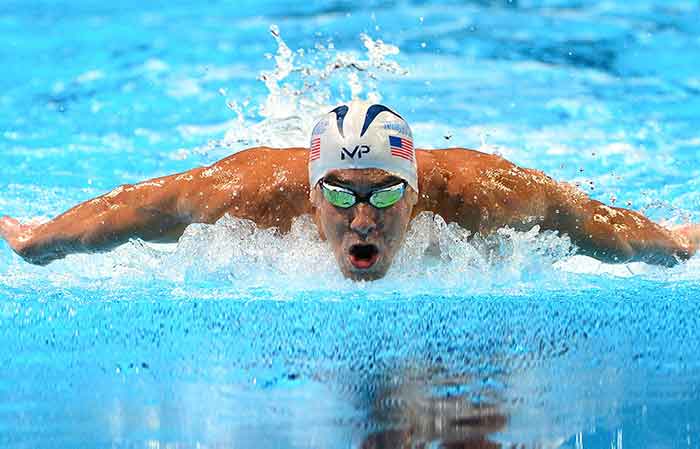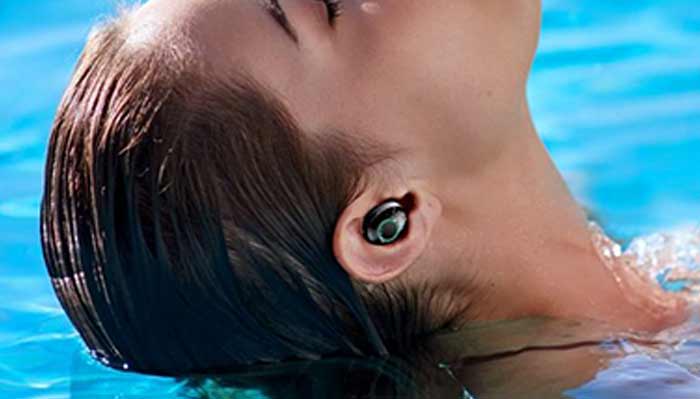How to Put on a Swim Cap: Long, Short, Curly Hair, Braids & Take-Off Tips
Be it you’re a casual or a competitive swimmer, putting on a swim cap properly is essential to not only protect your hair but also for a comfortable and streamlined swimming experience.
From preparing your hair to adjusting the cap, the following is a step-by-step process of donning a swim cap by yourself, ensuring a snug and secure fit whether you’re a woman with long hair/braids or a man with short hair.
In addition, find pro tips to make wearing your cap easier and faster, how to help a child wear a cap, frequently asked questions, steps to correctly take off, and care of your swim cap after use.
1. Prepare Your Hair
Before wearing a swim cap, it’s a good idea to take a few minutes to make your hair ready. This is important because it ensures that your hair is in the best condition and it also lets you have a smoother and more efficient experience when you’re putting it on.
So, you’re probably asking yourself, how do I prepare my hair? Preparing your hair includes;
Gently Combing or brushing your short hair to remove any tangles or knots
Gathering and securing long hair high in a low bun or ponytail to reduce volume and keep it contained
Wetting or dampening your hair with clean chlorine-free water to flatten your hair and reduce its volume, making it easier to fit inside the cap. It also helps to reduce friction between your hair and the cap, making the cap application smoother and more comfortable.
Smooth out your hair to ensure that your hair is neatly contained and won’t create lumps or discomfort when putting on the cap.
2. Stretch the Cap
After preparing your hair the next step is to carefully grab the cap with your hands and prepare it for a stretch.
There are two ways to grab and stretch your cap;
The first technique is to use the backs of your hands to push the cap outward to the side from the center seam. Simply place both hands in the cap, palms facing each other, fingers slightly bent inwards like you are holding a ball, then stretch it open as wide as possible. This is the most efficient way especially if have long fingernails that may pierce the cap.

The other technique of holding and stretching is by placing your two thumbs inside the cap, and rolling it inside out over the other fingers to create something sort of a small bucket. While the fingers are still holding by the edges, gently stretch it apart.

Be sure to stretch it above your head rather than at eye or chest level. When overhead, it is easier to determine how much stretch you need for your head size or hair volume.
3. Position and Pull
Once you’ve got the cap stretched wide, it is time to place it over your head. Depending on the length or volume of your hair, you can start from the back of the head to the front or from the forehead to the back of the head.
If you have long hair, bend over slightly and place the inside of the cap at the back of your head covering the bun or ponytail first, then gradually work your way toward the front, until the front of the cap sits in the middle of your forehead, somewhere below your hairline and above your eyebrows
If you have short or medium hair length, lower it and catch the inside of the cap’s front(edge) on your forehead first, then quickly pull it over the crown toward the back of your head until the back inside of the cap snugly sits just above your hairline at the base of your neck.
4. Make Final Adjustments
Once the swim cap is fully stretched over your head, adjust it to ensure a snug fit. Use your fingers to smooth out any wrinkles or air pockets as you go.
From the front, ensure that you pull down the cap to the middle of the forehead, rather than sitting on the hairline so that it does not slip off as you dive into the pool and swim.
From the back, make sure that the cap covers your hairline completely and extends down to the nape of your neck. gently tug on the cap at the sides and back to ensure it sits securely on your head. If needed, adjust the position of the cap to align it properly.
It may take a few tries to get it right, but once you do, make sure your hair is completely tucked in and the cap is tightly sealed. Depending on the type of cap you have, your ears should be covered about halfway or completely.
Wearing a Swim Cap with Long Hair or Braids
To wear a swimming cap with long hair, braids, or dreadlocks, follow the steps below
- First, find an extra-large swim cap that is designed for long hair or braids. If you have to use the regular caps choose silicone ones, which stretch enough to accommodate long and voluminous hair.
- Once you’ve got the right cap in place, remove any hairstyling objects like clips, metals, seashells or hairpins that can damage the cap.
- Tie your hair or braids in a ponytail or a tight bun (if you have extremely long hair) to keep it contained and prevent it from interfering with the swim cap’s fit. Use a hair tie or an elastic band to secure your hair in place and make sure it’s sitting high on your head.
- Wet your hair
- Stretch and position the cap
- Adjust as discussed earlier
Tip: You can also wear a mesh swim cap underneath to contain the hair then add on a silicone cap for an improved and secure fit.
How to Help a Child Wear a Swim Cap
Wearing a swim cap for a child is slightly different from the other ways of wearing it, as they may need help to put it on.
- First, explain what you will do to the child and reassure them that it won’t hurt.
- Hold the swim cap open using both hands, with your palms facing inward.
- Ask the child to tilt their head slightly so their hair falls forward.
- Place the cap on the back of the child’s head and ensure it sits flat against their skin.
- Gradually pull the cap upwards, using your fingertips to stretch it gently.
- Ensure that all the child’s hair is tucked into the cap so none sticks out.
- Adjust the cap as necessary to ensure a snug fit and prevent water from seeping in.
- Once the cap is in place, ask the child if they’re comfortable and adjust it if not.
Pro Tips to Ensure a Perfect Fit
Here are some tips and ideas for wearing swim caps that will make the experience a lot more comfortable and enjoyable:
Stretch the Cap
If your swim cap feels too tight or is new, stretch it out a few times with your hands before attempting to wear it. This gentle stretching will make the cap more flexible, easy to put on, and comfortable.
Leave-in conditioner
In addition to wetting your hair in the shower or using a spray bottle, you can also add a leave-in conditioner to make your strands sleeker and further protect them.
Use Talcum or Baby Powder
In addition to wetting or dampening your hair, you can sprinkle talcum/baby powder or some fresh water on the inside of the cap to reduce friction when wearing. This can also help keep it from pulling on your hair when you take it off
Explore Different Cap Designs
Consider trying different swim cap materials such as latex, silicone, or neoprene. Silicone caps are generally sturdy, and easier to put on and take off but may slip or move more. Latex caps are lightweight, and offer a tight fit but can be slightly more challenging to put on and cause allergic reactions, especially if you have any allergies to latex.
Neoprene caps on the other hand are bulkier but keep you warm in cold waters. Just experiment with different styles during workouts or practice races to find the one that suits you best.
Further Reading: Silicone vs Latex Swim Caps
Ensure Proper Alignment
Use the seam of the cap to ensure that the cap is properly aligned. The seam should span from your mid-forehead to the nape of the neck, at least for most caps.
If there’s no seam use the packaging crease that runs through the middle of the cap. The crease should sit at the center of the top of your head, straight through the middle from front to back.
If the seam or crease sits horizontally on your head, that is, it runs from ear to ear, it’ll create more drag in the water.
Another way to check if it is correctly placed is to use marks such as logos that indicate where the front, back and sides are. Other caps, especially those meant for long hair are roomier or bulge at the back.
Choose the right size
Swim caps come in different sizes, so be sure to choose one that fits snugly but not too tightly. A too-tight cap can cause discomfort or even headaches, while a too-loose cap will allow water to seep in and can slide off while you are swimming.
Try out two caps
For a more secure fit and enhanced hydrodynamics, many competitive swimmers wear two caps. The first cap acts as a sticky surface for goggles and makes it easier to wear the second cap, while the second cap reduces resistance. This combination minimizes the risk of losing your goggles during a start-dive and improves your overall swimming experience.
Protect your ears
If you’re prone to ear infections, consider wearing earplugs and your swim cap to keep water out of your ears. You can also buy a swim cap that is designed to cover your ears.
Treat Your Cap Gently
Swim caps are somewhat delicate, and a small rip or hole will quickly turn into a big one.
Never put your fingernails directly on the cap material especially when stretching or pulling it. You could possibly poke a hole in the cap. When tugging it into place, do so gently. A little care when putting on and adjusting your cap makes a big difference
If there’s a tear or a hole, as small as it can seem, stop using the cap; it will break while you are using it or the next time you use it.
Practice
Do not be afraid to try again and again. It may take a few tries to get it right, but after some practice, you’ll surely figure out how to quickly and painlessly put on a swim cap like a pro.
Seek Assistance
If necessary, enlist the help of someone to make wearing the cap easier. Someone’s assistance can help stretch the cap out wide enough to avoid catching any hair as you fit it over your head ensuring a smooth and snug fit.
Should you Wear Swim Cap or Goggles First?
When training it is a good idea to wear goggles after a swim cap since this setup does not dig into your skin, adds seal to the cap, and makes it easy for strap adjustment, take off, fog clearing and goggle swapping. However, this setup is not ideal if you are competing or diving from the blocks, goggles will easily slip off.
Putting on goggles before your swim cap can further reduce drag and keep the goggles secure underneath the cap especially when diving off blocks and competing. However, the goggle-first setup makes it difficult to take off the goggles and adjust the straps, can dig into your skin, and often breaks the cap seal.
Some competitive swimmers use two caps with goggles sandwiched in the middle, that is, lycra cap first, then goggles, and then another cap, mostly the silicone type. This technique is called double capping or layering.
How to Properly Take off a Swim Cap
Removing a swim cap can sometimes be a bit tricky, especially if you’re doing it for the first time or the cap itself fits snugly. Here’s a step-by-step guide on how to properly remove a swim cap:
- Position your hands: With both hands, position your fingers on either side of your head, just above your ears, thumbs pointing towards the back of your head.
- Release the suction: Use your thumbs to push the edge of the swim cap up and away from your head, creating a small gap between the cap and your scalp. This breaks the seal and releases the suction that holds the cap in place.
- Slide the cap off: Once you have broken the seal, keep your thumbs in that position and use your fingertips to slide the swim cap up and off your head. Gently pull the cap towards the back of your head, allowing your hair to come out of the cap gradually.
Removal Tips
- If you have long hair, be careful not to catch or pull your hair as you remove the cap. You can use your other hand to help guide your hair out of the cap and prevent it from getting tangled or caught.
- Resist the urge to forcefully yank the swim cap off your head, as this can cause discomfort or potentially damage your hair. Take your time and be gentle during the removal process.
Remember, practice and patience are key when it comes to removing a swim cap, especially if it fits tightly. Taking your time and using a gentle, controlled approach will help you remove the cap without any discomfort or hair tangles.
How to Clean and Keep Your Swim Cap
- After swimming, rinse your cap off in non-chlorinated water.
- Dry the cap off gently with a towel or allow it to hang dry.
- You can also sprinkle talcum or baby powder inside silicone caps and distribute it evenly. This drying technique not only prevents bacterial growth but also reduces stickiness, making it easier to put on and take off the cap. Additionally, it helps extend the cap’s durability
- Between uses, keep the cap in a case or a soft compartment of your bag to protect it from sharp objects.
FAQS
Following are some of the most commonly asked questions about wearing a swim cap with answers
Can you put a swim cap on dry hair?
You can try to put a swim cap on dry hair, but it is challenging. The cap will likely catch, pull, and be very tight without any moisture to help it glide on. It’s better to wet your hair first before applying a swim cap.
Is it easier to put on a swim cap with wet hair?
Yes, it is much easier to put on a swim cap if your hair is wet or damp first. The water acts as a lubricant that allows the cap material to stretch smoothly over your head without tangling or pulling the hair. Starting with wet hair makes getting a cap on and off a breeze.
How should a swimming cap fit?
A cap should fit snugly to your head without being painfully tight. It should cover your ears and most of your forehead. Long hair should be tucked inside. The cap should not slide off the back of your head while swimming. Ensure proper sizing – caps often run small
How do I keep my cap from slipping off?
Ensure you have the right snug-fitting cap size. Wet hair before putting it on. Tuck in stray hairs. Position properly. Use cap ties or strap adjusters if available. Smooth wrinkles. Swim streamlined and avoid unnecessary head movements. Replace overstretched caps or consider a different size or style if your cap won’t stay on
Can I wear two caps for extra protection?
Yes, double caps are fine if needed. Put a latex or silicone cap closest to your head, then layer on a looser lycra cap. Make sure hair is tucked under smoothly to prevent bumps. The outer cap helps hold the inner one in place.
Should my cap match my swimsuit?
Matching your cap to your swimsuit is an aesthetic choice – it’s not required. Choose a cap color/pattern you like. Solid colors are common for lap swimming. Printed lycra caps are popular for recreational swimming. Team caps match uniforms.
Can I swim without a cap?
Yes, you can swim without one especially if you’re bald or have short hair. However, most pools require caps and without a cap your hair will get wet and chlorine can damage it over time. Your head may also feel cooler without a cap.
Can I wear a cap if I have short hair?
Yes, caps can still benefit swimmers with short hairstyles. The cap keeps chlorine away from your hair and provides warmth. Shorter hair may require adjustable caps with chin straps to stay in place.
Are there caps made especially for long hair?
Yes, choose a swimming cap one size larger if you have long or thick hair. Look for extended sizing with more depth and width to accommodate more hair inside. Long hair caps have a dome shape and may contain more latex or silicone to stretch further.
What if my cap feels too tight?
Try stretching the cap gently before putting it on. Apply conditioner or cap lubricant inside the cap. Switch to a silicone or lycra cap for more give. Loosen any adjustable straps on the cap. Avoid overstretching latex caps. Get a larger size if needed for comfort.
Can I wear a cap if I have braids or dreadlocks?
Yes, but a standard cap may not fit over bulky hairstyles. Try extra large sizes, or look for caps designed for braids, dreadlocks, weaves, etc. The cap should cover as much hair as possible without squeezing tightly.
How do I get my child to wear a swimming cap?
Make it fun by letting them pick out their own colorful cap with a favorite character or pattern. Put the cap on a favorite stuffed animal first. Gently stretch the cap before placing it on their head. Praise them for wearing it and explain the cap’s importance. Be patient, it may take time.
Why do swim caps slip, fall or come off?
Swim caps can slip off due to improper sizing, a loose fit, frequent popping off the surface of the water, or the cap material being overstretched. Some swimmers also blame hair conditioners






